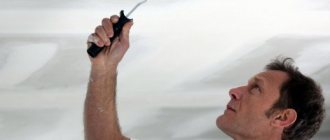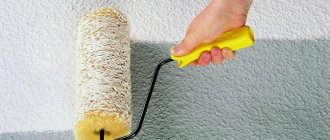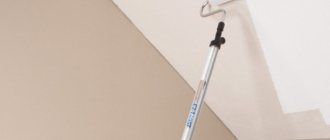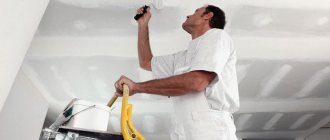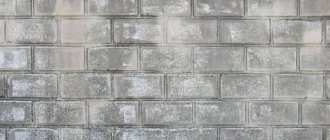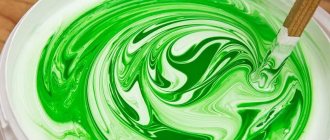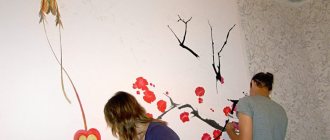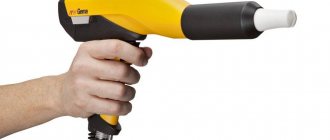Paints, varnishes, drying oils, oils
The following surface protection methods are traditionally used for wood:
- oil treatment is a rather expensive and not always quite effective method, mainly used for internal surfaces and household items;
- coating with drying oil is almost the same as for oil;
- varnishing is a very expensive method, used mostly for the preservation or restoration of wooden buildings of historical value;
- painting – the use of opaque paints on various bases provides a strong and durable protective film; with the right choice of coating, it allows you to preserve the structure of the material.
Taking into account the comparison of the cost of protective measures, painting the facades and decorative elements of wooden houses is certainly in the lead.
How to apply paint?
Facades are most often painted with a roller, brush or spray gun.
The choice of tool is determined by the consistency (viscosity) of the paint, the texture of the surface to be painted and the qualifications of the workers.
Walls with a smooth surface
Paint with a brush or short-haired roller. Painting with a roller is more convenient and faster than with a brush, and less paint is consumed.
When painting walls with a textured surface
or directly on the brick, use a wide brush with long bristles.
You can use a spray gun to paint walls of any texture.
, both smooth and embossed.
Painting a house with a spray gun requires performers to have higher qualifications and experience working with this painting machine. It is necessary to choose the right paint viscosity and select nozzles for the sprayer of the device. You also need practical skill in applying paint evenly to the surface of the wall. It is better to entrust painting a house with a spray gun to specialists.
In the case of using special high-viscosity textured paints with filler
, to apply paint to the facade, in addition to the above tools, they also use a spatula.
How to paint the outside of a wooden house
When choosing a coloring composition to paint a wooden house, you need to make sure that it:
- intended for outdoor use - this characteristic includes requirements for components such as protection from frost and ultraviolet radiation;
- is able to protect wood from biological hazards - prevents the appearance of mold and mildew, protects against insect pests (or repels them);
- closes wood pores to reduce moisture absorption. Only multilayer coating with dense compounds with special properties can completely eliminate absorption;
- prevents rapid abrasion of the surface.
As for the base composition, exterior paints vary in their base.
- Water-based acrylic. The base is acrylic resins that can dissolve in water (emulsify). Thanks to the presence of acrylic, a dense, vapor-permeable coating is created that does not prevent the wood from “breathing” and at the same time prevents moisture from penetrating into the pores of the material.
Water-based latex.
The base contains synthetic latex and acrylic. Thanks to this, the paints create a more durable and abrasion-resistant film that protects the wood well from ultraviolet radiation. In addition, latex improves the appearance of the surface and creates a silky feeling. The main property of latex is to maintain the elasticity of the coating and prevent cracking of the coating. Alkyd paints, also known as enamels. Less resistant to external influences, burn out relatively quickly. They do not penetrate deep into the fibers, so they are easily damaged. Plus - a beautiful glossy, matte or “satin” surface layer, excellent frost resistance (up to -30 degrees Celsius).
Oil paints. They are placed in last place due to low resistance to moisture and sunlight, rapid fading and poor mechanical protection.
Most manufacturers offer paints of one or two or all four types, adding to them special compounds for preliminary (before painting) treatment.
Important: all types of paints are divided into topcoat and glaze.
The first type allows you to completely paint over the color and, to some extent, the structure of the wood, the second type changes the tone of the wood while maintaining its texture. Topcoats include oil and partially alkyd, glazes include acrylic and latex (not all). Basically, the first two types of paints are used for painting facades, gables, doors, terraces and verandas, steps and fencing of porches and balconies, as well as shutters and frames of wooden windows. Alkyd paints are used where mechanical impact on products is minimal and there is no direct influence of moisture - for example, for frames and door panels located under a canopy or canopy. Due to their fragility, oil paints are used for unimportant buildings - fences, utility rooms.
Thus, deciding which paint is best to paint the outside of a wooden house should depend on the requirements for surface protection and the nature of the surface.
You should also consider the cost of paint and the cost of the job to match. Alkyd and acrylic paints are considered the cheapest (price greatly depends on the manufacturer). Their cost starts from 100 rubles per kilogram. Oil-based ones, paradoxically, are more expensive. This is due to the naturalness of their main component – drying oil. Latex paints are considered the most expensive.
Types of facade paints
The outer paint coating is classified according to its composition (based on the content of the binder). The coloring material intended for a particular coating includes certain elements that are optimally selected to ensure high-quality coloring.
Types of facade paints include:
- silicate;
- rubber;
- water-based;
- acrylic;
- latex;
- textured;
- silicone.
Silicate
The basis of such coloring compositions is liquid glass. Paints belong to the group of mineral paints. Dyes are of natural origin.
The main advantage of this type is its resistance to ultraviolet radiation. In addition, silicate compounds:
- do not deform under large temperature changes;
- mechanically resistant to natural phenomena;
- biologically stable;
- vapor permeable.
These coatings are noted for their durability.
Flaws:
Facade silicate materials are toxic , which requires the use of protective agents when painting. Silicate paints are incompatible with paints and varnishes, they are indelible and mechanically unstable.
Limestone
The main component in lime paints is slaked lime.
Advantages:
- vapor permeable;
- resistant to mold formation;
- inexpensive.
Flaws:
- unstable to precipitation;
- limited color options;
- get dirty easily.
This composition can be tinted, but it is not always advisable to use this method due to the possible formation of stains from precipitation.
Cement
The main binding component of these paint coatings is Portland cement with the addition of coloring pigments.
Cement compositions are similar in properties to lime ones, only one more disadvantage of this group of paints is the inability to resist bacteria , which further reduces the quality indicators of this façade coating. Compared to lime cement compositions, they are more resistant to precipitation.
Acrylic
These paint coatings contain acrylic resins. Acrylic compositions are presented in a wide range of colors; they are most popular for use for external painting.
Advantages:
- large selection of colors;
- abrasion resistant;
- almost do not absorb water;
- mechanically stable;
- elastic.
Flaws:
The main disadvantage of acrylic paint coatings is the low level of vapor permeability. Acrylic-based paints are quite expensive.
Silicone
Silicone compounds have a water-emulsion structure, the basis of which is silicone. Most common when painting facades.
Advantages:
Silicone materials repel water well, which is important for facade coatings.
In addition, silicone compositions have a number of advantages:
- mechanically stable;
- resistant to precipitation;
- vapor permeable;
- resistant to temperature changes;
- do not fade or crack in the sun;
- do not have static attraction: do not attract dust.
The silicone-based substance has good adhesion to various surfaces, which allows it to be used for many types of materials.
Flaws:
Silicone coatings are less elastic than acrylic resin materials. This type is an expensive composition.
In addition to the above compositions, there are oil-based coloring materials, but due to their more technologically advanced analogues, they are losing popularity due to a sufficient number of shortcomings.
In addition, there are high-tech coatings - rubber, which are expensive compounds and are the most elastic.
Rubber
In addition, there are high-tech coatings - rubber , which are expensive compounds and are the most elastic. However, due to such advantages as water resistance, high vapor permeability, temperature resistance and environmental friendliness, this type of paint is becoming increasingly widespread as a façade exterior coating layer. You can find out more about the pros, cons and features of using this material in our article here.
Let us note that the most popular in Russia and at the same time objectively the most profitable rubber paint today is “Universal” from (St. Petersburg). The material at the link also provides complete information about the manufacturer and this model.
With similar and even better characteristics compared to analogues like Super Decor Rubber, consumption is almost four times less and amounts to up to 150 grams per square meter . Thus, when using Mizar Universal, painting the facade will cost four times (!) less.
It should be noted that some manufacturers use styrene-acrylic latex in rubber paints to achieve low prices. As a result, such a coating cracks and crumbles after 3-4 weeks of periodic contact with water and/or under the influence of ultraviolet solar radiation.
On the contrary, in “Mizar Universal” production styrene-acrylic latex is completely absent , and increased moisture and water resistant properties allow this product to be successfully used for objects such as swimming pools and artificial reservoirs.
What paint to paint the outside of the house: compatibility of the base and top coat
If the house has just been built or is lined with wood, the question of choosing paint is completely arbitrary - the wishes of the owners and their financial capabilities are taken into account. The situation is different for facades that were previously painted or exposed with another protective composition.
If possible, you should find out exactly what composition was used. Thus, oil paints can be applied to a surface previously treated with drying oil, but it is not advisable to apply it to a surface painted with water-based paint - poor adhesion is possible. Any other paint will not work on walls previously painted with oil paint or, especially, enamel. Even for oil paint, you will have to first clean the surface from the remnants of the old coating and sand it - all the irregularities will instantly appear under a layer of fresh paint.
It is also important to correctly select the preparatory composition - wood primer or impregnation - with the material chosen for finishing. Ideally, both substances should have the same manufacturer and be combined in components.
How to paint the outside of a timber house to preserve the beauty of natural wood
A significant portion of manufacturers of façade paints and protective coatings for wood offer options that completely change the appearance of the material - they hide both the color and texture of the wood - and so-called “transparent” or “glazing” compositions. The second option is most suitable for people who want to paint a house made of timber and preserve the natural appearance of a wooden building and at the same time protect it from the negative influence of the environment.
As an example, we will give paints from some popular manufacturers with a possible palette of colors after finishing (pine wood is proposed as the base, as the most popular and cheapest).
Azure is a translucent glaze paint with protective properties; it can be thin, medium and dense.
What’s interesting is that if topcoat paints give a constant color and the number of layers has little effect on the tone, then glazing compositions allow you to get different shades depending on the number of layers.
Glazing compositions based on acrylic and acrylic-latex are not always called paints. Often these are complex compositions with a number of additional properties:
- antiseptic;
- antifungal;
- insecticidal;
- protection against cracking;
- and so on.
Important: both topcoat paints and glazing agents can produce glossy, semi-gloss and matte surfaces. The choice of one option or another depends on the desires of the owner of a wooden house, but in general, for buildings and parts made of wood, a matte or semi-matte effect is considered optimal - this makes the painted material more similar to natural, untreated.
Green algae on the facade - how to prevent and remove
Green algae on a wall always indicates high humidity, which encourages algae growth.
Houses located near forests and parks, in areas with high humidity (near bodies of water), are especially vulnerable to biological pollution. Mainly only the northern and western walls are susceptible to green invasion. This is due to the fact that winds from the west blow more often, and rain falls on the walls from these directions, and the sun is less frequent in these places. Algae and fungal spores thrive on damp surfaces, and on south-facing walls the sun dries out the façade.
It is enough to disinfect walls with a slight degree of contamination with a preparation to combat microorganisms, and then rinse them with water under pressure. If after disinfection traces of algae remain, then the color will need to be restored - paint the façade with paint containing biocides.
It should be remembered that the active period of most biocides is from three to five years. After this time, in areas particularly susceptible to microbial contamination, facades should be re-protected by spraying the product. I know of no means of providing long-term permanent protection against algae.
The appearance of algae should be prevented regularly, because prolonged exposure to it not only spoils the paint, but can lead to weakening and damage to the plaster.
Small cracks in the plaster layer can be filled with putty. It is convenient to apply it from a cartouche, the tip of which must be cut so that a thin stream of mass is created.
The depressions after impact are filled with a mass applied with a spatula.
More Articles on this topic:
⇒ Decorating the walls of the house with facade plaster ⇒ Which facade paint to choose
More articles on this topic
- Materials for the construction of a single-layer external wall of a house
- How to make an entrance vestibule in a private house
- Malfunctions and errors of the gas boiler Ariston, Protherm, Baxi
- Ventilation of the attic and upper floors of a multi-storey building
- Economy class house
- How to remove the smell of hydrogen sulfide from water in a well, boiler, well
- Frost index on the map
- Apartment redevelopment - fresh ideas
How to paint OSB board outside the house
For frame houses covered with OSB boards, there is no question of maintaining a natural appearance. Slabs rarely look so attractive that owners want to preserve its texture. Therefore, the best option would be topcoat paints or dense acrylic water-based compositions. They create a high-quality and fairly thick layer of coating, which ensures long-term preservation of the material. It should be borne in mind that OSB is less susceptible to attacks by rodents and insects, is less likely to be affected by mold and mildew, but is much more susceptible than solid wood to moisture. Therefore, painting compositions should be selected with maximum moisture-proof properties, and before painting it is advisable to additionally treat the surface with a special primer.
Important: the edges of OSB boards are quite porous, so they should be pre-sealed and/or painted in two layers.
Another important nuance: the use of water-based paints can lead to deformation of the slab. Therefore, whenever possible, elements are painted simultaneously on both sides; the dye is applied in thin layers and only after the previous layer has dried. If this is not possible, but you need to decide how to paint OSB on the outside of the house, it is better to choose a dye without a water base.
How to store paints?
Paint packaging should be protected from direct sunlight and frost. The paint should be stored at temperatures from +5 to +25 degrees C in tightly closed packaging. Paint stored under such conditions remains usable even after the expiration date indicated on the packaging.
Products for construction and repair
⇆
If the paint has flaked during storage, mix it thoroughly with a mixer attached to an electric drill, and the paint will become usable again.
What if there is a fire?
When deciding what is the best way to paint the outside of a wooden house, you should pay attention to compounds with fire retardant (fire retardant) properties. Usually these are not dyes, but base impregnations. For the most part, they are colorless, do not “clog” the wood texture, and additionally have antiseptic and bioprotective additives.
Complex formulations – antiseptics with glazing properties – are very popular. When using such a substance, they “kill two birds with one stone” - they protect the wood from harmful influences and give it the desired color.
What color to paint a wooden house outside: photos and recommendations
Once the type of dye is selected, all that remains is to choose the color. Traditionally, either shades are chosen that correspond to valuable types of wood, or tones that are more radically different.
So, in Scandinavia they prefer cold shades of light colors - white, gray, bluish or greenish colors, which go well with the “cold” nature around.
However, bright, juicy colors also look great in an “icy” environment – apparently by contrast.
Before painting the outside of a wooden house, you should decide on the color scheme. The color for the facade of the house should look harmonious with the color of the roof, creating a holistic and elegant ensemble.
| Roof color | ||||||||||
| Blue | Dark blue | Dark green | Brown | Chocolate | Orange | Red | Cherry | Dark grey | ||
| Wall color | Light blue | + | ++ | – | ++ | ++ | — | – | ++ | ++ |
| Turquoise | — | — | — | ++ | — | — | — | + | + | |
| Light green | – | – | – | ++ | ++ | – | ++ | + | + | |
| Yellow | ++ | ++ | ++ | + | ++ | ++ | ++ | ++ | ++ | |
| Beige | ++ | ++ | ++ | + | ++ | ++ | ++ | ++ | ++ | |
| Pink | + | ++ | ++ | – | ++ | — | — | ++ | ++ | |
| Pearl gray | + | + | — | + | – | – | + | ++ | + | |
| White | ++ | ++ | ++ | ++ | ++ | ++ | ++ | ++ | ++ | |
“ ++ ” – Excellent combination “ + ” – Good combination “ – ” – Not a very good combination “ — ” – Bad combination
When choosing a future color for the facade, explore options for a successful combination of shades.
What is the best tool to paint the outside of a wooden house?
| Advantages | Flaws | |
| Brush |
|
|
| Roller |
|
|
| Spray gun |
|
|
How to paint the facade of a brick, panel or frame house - instructions and useful tips
The entire process of painting a facade can be represented in the form of a simple algorithm.
First, apply a primer to a cleaned and prepared surface (leveled using plaster or puttying of defects). A special composition is necessary to ensure better adhesion of the painted surface to the paint. These formulations may contain antiseptic agents, in which case you will be able to save time and save your strength.
If the primer does not have antifungal components, then after it has completely dried, you will have to apply an antiseptic solution (from mold, bacteria, insects, fungi) and wait again.
The third and final stage is applying paint. You can watch the video on how to effectively paint your country house.
Video: painting the facade of a house
To obtain a high-quality result, do not neglect the recommendations for painting the facade:
- First of all, the corner parts of the building are painted.
- Work your way through the painting process from the top of the exterior walls to the bottom areas.
- Do not start work when it is raining or when the façade is exposed to direct ultraviolet rays.
- In your work, use brushes of different sizes - for better painting of all parts of the facade.
- Do not apply a new coat of paint until the previous one has completely dried.
- Elements that do not need to be painted with this color should be covered using polyethylene, masking tape or other available means.
- When painting at height, follow safety rules - it is better to use a safety rope or something similar.
- Protect your respiratory system with a mask, and hide your hands and feet under appropriate clothing (especially when using a spray gun).
Necessary safety measures will help maintain your health
Painting the exterior of a building can radically change the appearance of a building if you use the right tool and the right paint. Try to follow the recommendations of master painters in your work, then the façade coating will delight you for a long time.
